Cia Rinne, "Sounds for Soloists" @ Grimmuseum Review
Cia Rinne, "Sounds for Soloists" @ Grimmuseum Review

Cia Rinne believes that if you only speak one language you are limited in your thinking because you can only express things in one way. In her show, Sounds for Soloists, at Grimmuseum, Rinne showcases her ability to express herself through an impressive array of languages, including English, German, French, Swedish, Italian, and Spanish.
While studying philosophy at university, she because interested in how language was being used; the academics were painstakingly particular in their word choices, and sometimes the resulting text would be convoluted and a bit peculiar. In her work, she tries to reduce language in order to get at its essence. Presented at Grimmusem are three sound works in different forms accompanied by the visual text works on the walls. Most people don’t go to the gallery in the mood to do a lot of reading, but since the texts are succinct and playful, it is impossible not to want to read them all!
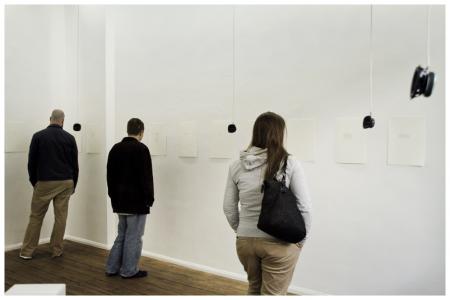
The first impression of the text pieces is a nostalgia for the heyday of visual and concrete poetry, but after engaging with the work it is apparent that it is a self-aware contemporary take on this poetic tradition. Some works call to mind Yoko Ono’s Instruction Paintings because they suggest that the reader perform an action, and it is probably not a coincidence that there is a piece in the exhibition that is a play on “oh no” and “ono.” There is even a nod to the poet and artist Emmett Williams in a piece that dissects his first name.
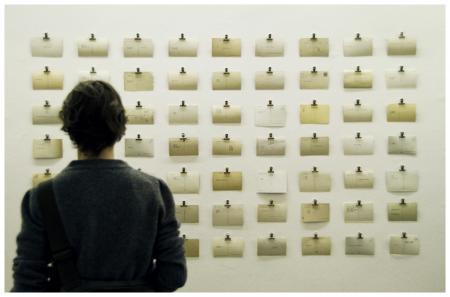
One work that uses repitition, similar to many concrete poems before it, acknowledges the computer’s autocorrect function that changes “joseph beuys” to “joseph buys.” Using this misunderstanding with the computer to her advantage, the result is that Joseph buys a felt suit and a fat corner among other things that are actually the titles of his artworks. This poem is an example of how Rinne’s work goes beyond her predecessors’; not only is it a visual poem, but it speaks about art history and our interactions with technology.
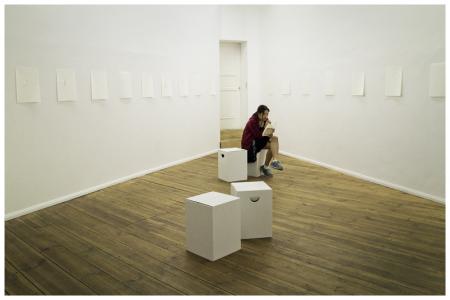
Rinne does not use a simulated typewriter computer font, but uses an electric typewriter to produce the works on paper. The typewriter slightly embosses the paper with the letters, a quality that cannot be achieved with an inkjet print, attributing the text with a more sensual physicality.
Especially regarding her earliest work, normal">zaroum, Rinne was interested in playing with graphic qualities of language. She was asked to do a reading of this work, which naturally proved difficult due to its emphasis on the visual. Even though it was not an easy task, hearing the works out loud lead to an interest in the audial properties of language, and the next body of work was more geared towards sound. A notable example is a piece that is a combination of English and German and the words “war” and “was.” It is nearly impossible to decipher the text just by reading it; it is the pronunciation that attributes meaning to the work.
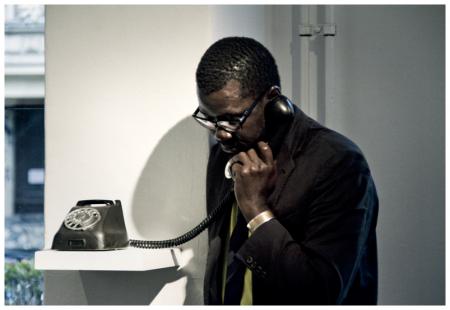
The three sound works are derived from the written texts. notes for telephone (2012) uses an old rotary phone to transmit Rinne’s reading intimately into the ear of the listener. Seven speakers are suspended from the ceiling in the piece sans y/eux and the text jumps playfully from different locations. Her collaboration with the composer Sebastian Eskildsen, in which he analyzed her readings and produced a composition for each piece plays from the ceiling. In each sound work, and in the live performance as well, Rinne’s voice moves effortlessly between languages, as if speaking one.
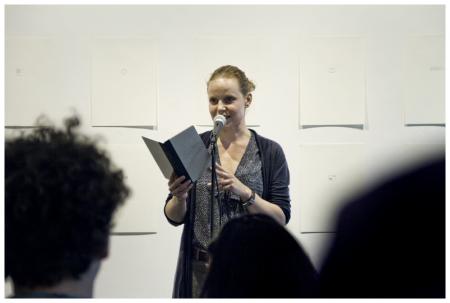
The show is on view until 22 July 2012, and there are two more performances coming up. I promise it will make you want to sign up for language classes this summer...
More information can be found here: http://grimmuseum.com/